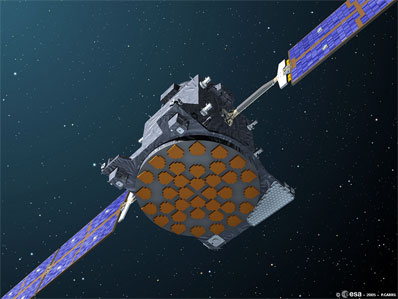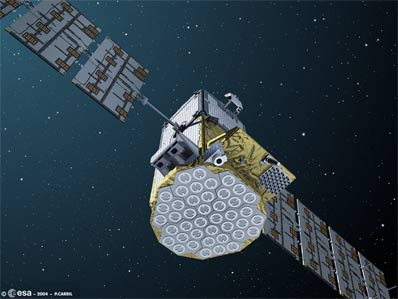
Spaceflight Now +

|

|

|

|

Premium video content for our Spaceflight Now Plus subscribers.

Mountains of creation
 A new image from NASA's Spitzer Space Telescope reveals billowing mountains of dust ablaze with the fires of stellar youth. The majestic infrared view from Spitzer resembles the iconic "Pillars of Creation" picture taken of the Eagle Nebula in visible light by NASA's Hubble Space Telescope. A new image from NASA's Spitzer Space Telescope reveals billowing mountains of dust ablaze with the fires of stellar youth. The majestic infrared view from Spitzer resembles the iconic "Pillars of Creation" picture taken of the Eagle Nebula in visible light by NASA's Hubble Space Telescope.

 Play video Play video

Space history: STS-51A
 This week marks the anniversary of arguably the most daring and complex space shuttle mission. The astronauts successfully launched two satellites and then recovered two others during extraordinary spacewalks by astronauts using jet-propelled backpacks and pure muscle power. This week marks the anniversary of arguably the most daring and complex space shuttle mission. The astronauts successfully launched two satellites and then recovered two others during extraordinary spacewalks by astronauts using jet-propelled backpacks and pure muscle power.

 Play video Play video

Space station EVA
 Commander Bill McArthur and flight engineer Valery Tokarev conduct a 5 1/2-hour spacewalk outside the International Space Station, installing a TV camera, doing repair chores and jettisoning a failed science probe. Commander Bill McArthur and flight engineer Valery Tokarev conduct a 5 1/2-hour spacewalk outside the International Space Station, installing a TV camera, doing repair chores and jettisoning a failed science probe.

 Play video Play video

The Earth from space
 Return to flight space shuttle commander Eileen Collins narrates an interesting slide show featuring some favorite photographs of Earth taken during her previous shuttle missions. Return to flight space shuttle commander Eileen Collins narrates an interesting slide show featuring some favorite photographs of Earth taken during her previous shuttle missions.

 Play video Play video

Griffin testifies
 NASA Administrator Mike Griffin goes before the U.S. House of Representative's Science Committee to provide an update on the moon-Mars exploration program, the future of the space shuttle and space station, possible servicing of Hubble, cost overruns on the James Webb Space Telescope and the agency's aeronautics research. NASA Administrator Mike Griffin goes before the U.S. House of Representative's Science Committee to provide an update on the moon-Mars exploration program, the future of the space shuttle and space station, possible servicing of Hubble, cost overruns on the James Webb Space Telescope and the agency's aeronautics research.

 Play video Play video

Dale hearing
 The Senate Commerce Committee holds a confirmation hearing on President Bush's nomination of Shana Dale to be the new NASA deputy administrator, replacing former astronaut Fred Gregory. The Senate Commerce Committee holds a confirmation hearing on President Bush's nomination of Shana Dale to be the new NASA deputy administrator, replacing former astronaut Fred Gregory.

 Dial-up | Broadband Dial-up | Broadband

Astronaut Q&A
 As NASA celebrates five years of continuous human presence aboard the International Space Station, former resident astronauts from Expedition crews who lived aboard the outpost held this recent question and answer session at the Johnson Space Center. As NASA celebrates five years of continuous human presence aboard the International Space Station, former resident astronauts from Expedition crews who lived aboard the outpost held this recent question and answer session at the Johnson Space Center.

 Dial-up | Broadband Dial-up | Broadband

Shuttle engine test
 For the first time since Hurricane Katrina, NASA's Stennis Space Center in Mississippi conducts a test-firing of a space shuttle main engine. The engine was run as part of a certification series on the Advanced Health Management System, which monitors engine performance. For the first time since Hurricane Katrina, NASA's Stennis Space Center in Mississippi conducts a test-firing of a space shuttle main engine. The engine was run as part of a certification series on the Advanced Health Management System, which monitors engine performance.

 Play video Play video

Edwards air show
 Edwards Air Force Base hosted an open house and air show this past weekend. NASA's Dryden Flight Research Center demonstrated some of its specialized aircraft -- a highly modified NF-15B, a high-altitude ER-2, and F/A-18 and T-34. On the ground, a variety of specialized air and space vehicles were on display in the NASA exhibit, ranging from the Mars rovers to the 747 space shuttle carrier aircraft. Edwards Air Force Base hosted an open house and air show this past weekend. NASA's Dryden Flight Research Center demonstrated some of its specialized aircraft -- a highly modified NF-15B, a high-altitude ER-2, and F/A-18 and T-34. On the ground, a variety of specialized air and space vehicles were on display in the NASA exhibit, ranging from the Mars rovers to the 747 space shuttle carrier aircraft.

 Play video Play video

ISS science 'suitcases'
 Scientists eagerly examine suitcase-like packages, called the Materials International Space Station Experiments, or MISSEs, after return to Earth. The MISSE packages were flown outside the orbiting station to expose different materials to the space environments for study. Scientists eagerly examine suitcase-like packages, called the Materials International Space Station Experiments, or MISSEs, after return to Earth. The MISSE packages were flown outside the orbiting station to expose different materials to the space environments for study.

 Play video Play video

Tracking hurricanes
 This 2005 Atlantic hurricane season has a been a record-breaker. Satellite imagery since June 1 has been compiled into this movie to track the 21 named storms as they formed and traveled, many making landfall. This 2005 Atlantic hurricane season has a been a record-breaker. Satellite imagery since June 1 has been compiled into this movie to track the 21 named storms as they formed and traveled, many making landfall.

 Play video Play video

 Become a subscriber Become a subscriber
 More video More video

|

|

|

|
|

|

Europe's first Galileo satellites named 'GIOVE'
EUROPEAN SPACE AGENCY NEWS RELEASE
Posted: November 11, 2005
GIOVE - standing for 'Galileo In-Orbit Validation Element' - is the name that has been chosen for the two satellites which are currently being prepared to take the first step of the In-Orbit Validation phase towards full deployment of Galileo, the European satellite navigation system.
The name GIOVE was announced by Ms Karla Peijs, the Dutch Minister of Transport, Public Works & Water Management, on Wednesday, at ESA's ESTEC centre in Noordwijk (The Netherlands).

An artist's impression of GIOVE A, formerly known as GSTB-V2/A, orbiting in space. Credit: ESA
|
GIOVE A, the first of the two satellites, was presented to the media while undergoing final preparations at the ESTEC test facilities prior to being sent to the Baikonur cosmodrome in Kazakhstan, from where it will be launched by a Soyuz rocket at the end of December 2005. The second, GIOVE B, will be launched later in 2006, also from Baikonur.
Naming the satellites GIOVE pays fitting tribute to the achievements of Galileo Galilei (1564-1642) not only in the field of astronomy but also navigation. On 7 January 1610, as one of the first to turn his telescope to the sky, the famous scientist discovered the first four satellites of the planet Jupiter. These were later named Io, Europa, Ganymede and Callisto. Galileo realised that the formation of these four satellites, whose eclipses are frequent and visible, provided a clock whose face could be seen from every point on the Earth.
Tables describing the motion of the first four Jovian satellites to be discovered were used to determine longitude at sea and on land. Galileo's method of determining longitude by observing the eclipses of Jovian satellites heralded a revolution in navigation, geodesy and cartography in the 17th and 18th Centuries.

An artist's concpet depicts the Galileo satellite constellation. Credit: ESA-J. Huart
|
Almost 400 years on, another revolution in navigation is on its way, with the advent of Europe's Galileo positioning infrastructure. GIOVE satellites A and B mark the start of in-orbit validation of this new system. They will be followed by four other satellites, to be launched in 2008.
GIOVE and its four successors will pave the way for the deployment of the complete Galileo constellation of 30 satellites. This will provide unprecedented satellite positioning, navigation and timing capabilities in the 21st Century.
Background notes for editors
This first step in the Galileo programme, known as the Galileo System Test Bed (GSTB), involves the launch of two satellites for in-orbit testing of critical technologies such as atomic clocks and novel navigation signals specifically developed for the programme. It will also secure the frequencies allocated to Galileo by the International Telecommunications Union (ITU).
Until now going under the more technical names of GSTB-V2/A and GSTB-V2/B, these first two GIOVE satellites are elements of the In-Orbit Validation phase of the Galileo programme. GIOVE A (GSTB-V2/A) is at present undergoing its final environmental test campaign on the facilities at the Agency's ESTEC test centre. The second, GIOVE B (GSTB-V2/B), is undergoing final integration tests on the Alenia Spazio facilities in Rome (Italy).
Thus, Galileo, Europe's innovative satellite navigation system, is getting ready for launch, preparing to deliver an innovative and advanced civil global positioning service for the benefit of citizens throughout Europe and worldwide.
GIOVE A is being developed by Surrey Satellite Technology Ltd (UK). It is designed to fulfil the following main objectives: secure frequency filings, validate key technologies such as rubidium clocks, characterise the orbital environment and deliver signal broadcasting using two transmission channels in parallel.

An artist's impression of GIOVE B, formerly known as GSTB-V2/B, orbiting in space. Credit: ESA
|
GIOVE B, which is designed to fulfil similar objectives, is being developed by Galileo Industries, a European consortium comprising Alcatel Space Industries (F), Alenia Spazio (I), Astrium GmbH (D), Astrium Ltd (UK) and Galileo Sistemas y Servicios (E). This satellite also provides complementary features such as a passive hydrogen maser clock and simultaneous three-channel transmission.
The Galileo programme is being implemented in three phases:
- Definition
- Development and In-Orbit Validation
- Full Deployment and Operations
The forthcoming In-Orbit Validation phase will be completed with the deployment of a constellation of four satellites (the minimum number needed to guarantee the exact position and time at test locations), along with the provision of a number of associated ground stations. Eventually, the Full Deployment phase will cover the manufacturing and launch of the 26 additional satellites completing the Galileo constellation plus the completion of the ground segment comprising an extensive network of stations and service centres.
Galileo is a joint initiative of the European Commission and the European Space Agency. It is the first satellite positioning and navigation system specifically designed for civilian purposes and will offer state-of-the-art services with outstanding performance guaranteeing accuracy, integrity, continuity and availability.
|

|

|

|


|



